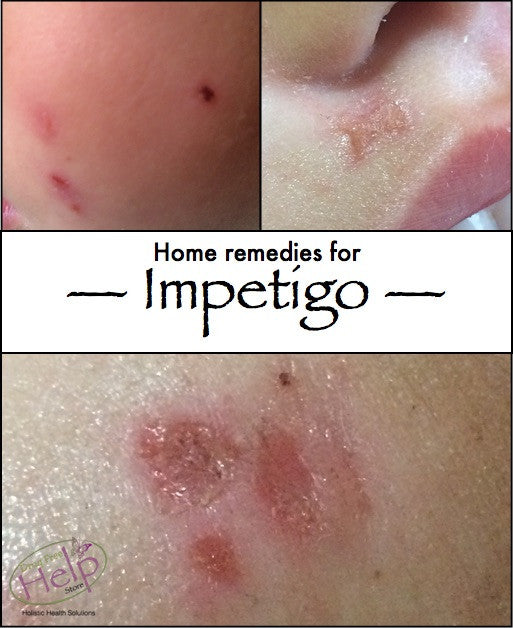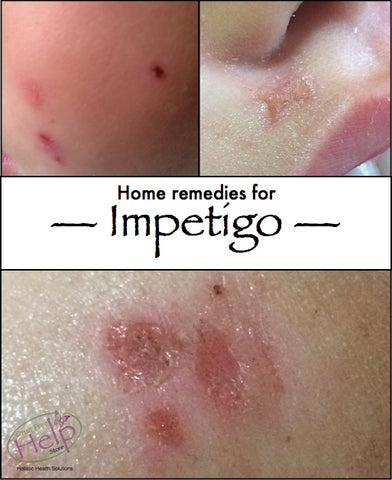
Home Remedies for Impetigo

What is impetigo?
Parents often describe it as a rash. It is a contagious bacterial infection of the skin.
Two types of bacteria are the main culprits of Impetigo. Most of the time, streptococcus bacteria (the ones responsible for strep throat & scarlet fever) or staphylococcus (staph) bacteria cause of impetigo.
Who can get impetigo?
It is by far most common in young children and infants. They have more fingers in their nose, more colds, more scrapes and small cuts, and more bug bites – all allowing the bacteria to get in.
Children with eczema are more prone to impetigo.
How do I know if it is impetigo?
There are two classic forms of impetigo — with blisters (bullous impetigo) and without blisters (nonbullous impetigo).
Fluid-filled blisters can form on the face, and pretty much anywhere on the body. The blisters break and oose easily, leaving a rim of dead skin around a raw, moist sore that might form a scab.
Bullous impetigo is almost always caused by staph.
Impetigo without blisters is most common near the ears, nose, or mouth, but it can show up anywhere on the body. It usually begins as a small red patch or a blemish, which spreads to a larger honey-crusted sore. The infection can spread under the skin to other parts of the body. It can also spread to other areas of the body by fingers, clothes, or towels.
It sometimes itches and scratching it can spread it.
Is impetigo contagious?
Impetigo is quite contagious. It can be spread by touch and by shared objects, such as towels or washcloths. Impetigo is teeming with aggressive bacteria, but the bacteria cannot enter intact, healthy skin. Others can easily catch impetigo if the bacteria encounter a break in their skin.
Impetigo is contagious until the rash has disappeared.
How long does impetigo last?
Nonbullous impetigo will usually clear on its own within two weeks (with no scarring). Bullous impetigo will typically last much longer.
Treating Impetigo
Submitted by: Lynn Applegate
My Toddler recently contracted Impetigo. I didn't realize what it was until it was pretty bad. It started out with a bug bite that she wouldn't stop picking at. It quickly turned into a huge oozing sore. My sister told me that she used her Tea Honey Concentrate on impetigo with great success, so I had to try it. WOW! It worked great! I decided to research why it was so effective and here are the results and instructions.
1) Tea Honey Concentrate (Honey & Vinegar)
is an amazing powerhouse for fighting infection. Honey has been used for centuries for healing wounds. It kills bacteria resistant to other antibiotics and actually heals tissue, nursing the skin back to health. Apple Cider Vinegar is very effective against 20% virus and 82% standard mold, making it a remarkable anti-microbial agent. A topical application of undiluted vinegar is an effective remedy for ringworm, impetigo and athlete’s foot.
I had used vinegar on impetigo and it worked OK but when my sister said she used a mix of honey and apple cider vinegar with amazing results I couldn't resist. I followed the following recipe for Tea Honey Concentrate. I cleaned the impetigo with a wipe and then applied the Tea Honey Concentrate to the sores with a Q-tip. I repeated this 3-6 times a day until it was gone. I also had them drink alot of the Tea Honey drink, because it helps your body to fight infections and regulates pH. The Impetigo immediately started drying up and she stopped picking at it. Within a few days it was mostly gone and totally gone within about a week.
TEA HONEY CONCENTRATE
2 cups Apple Cider Vinegar
4 cups Raw Honey
TIP: If you make sure your mixing and storage containers are completely dry before use, your concentrate will last a long time. Water shortens the storage time to about a week in the fridge.
mix together and store in dry, air tight container
This works best if your honey is runny, Otherwise you will need a blender to mix it. I put my crystalized honey in a glass jar, in a sauce pan with a few inches of water in the pan. Bring water to a boil and then turn it down. simmer until honey is softened, stirring occasionally.
HOW TO USE THE CONCENTRATE:
(as a drink)
- For a quart tea mix ½ cup concentrate with 4 cups water.
- For a gallon mix 1 1/2 cups of concentrate in a gallon pitcher or jug and top off with water.
2) Fight the infection from the inside:
Impetigo often starts with a runny nose and spreads everywhere the nose runs so it is important to treat the cold or flu that has the nose running. I swab the inside of the nose using a Q-tip and Comfrey Gold Salve or coconut oil. I also give them FECTION, a probiotic that is amazing at fighting infections. Here is an infographic that might help with other symptoms.
3) Prevention
Prevention is the best method. Healthy skin is remarkably resistant to infection. It is a powerful barrier for keeping the billions of bacteria outside. When bacteria enter the skin through a break in this skin, an infection can result.
Since children are most prone to impetigo it is a good idea to keep them clean. Moisturize their skin with coconut oil because of its anti bacterial nature and ability to build healthy skin. I like to put a 1/4 cup of vinegar in the kids bath to balance the pH of their skin and then rub them down with coconut oil when they get out of the tub.
I also put vinegar in the rinse cycle when washing their bedding and clothing to disinfect.
Disclaimer: This post is for general information only and not meant to be your only source of information on the topic. Use at your own risk. Please consult your health-care provider for personal advice.

